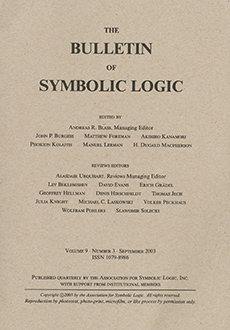Abstract
Let $M$ be a smooth, compact manifold of dimension $n\geq 5$ and sectional curvature $ |K| \leq 1$. Let Met($M$) = Riem($M$)/Diff($M$) be the space of Riemannian metrics on $M$ modulo isometries. Nabutovsky and Weinberger studied the connected components of sublevel sets (and local minima) for certain functions on Met($M$) such as the diameter. They showed that for every Turing machine $T_e, e \in \omega$, there is a sequence (uniformly effective in $e$) of homology n-spheres {$P_k^e$}$_ k\in\omega$ which are also hypersurfaces, such that $P_k^e$ is diffeomorphic to the standard $n$-sphere $S^n$(denoted $P_k^e \approx_{\rm{diff}} S^n$ iff $T_e$ halts on input k, and in this case the connected sum $N_k^e = M \# P_k^e \approx_{\rm{diff}}M$, so $N_k^e \in $Met($M$), and $N_k^e$ is associated with a local minimum of the diameter function on Met(M) whose depth is roughly equal to the settling time $\sigma_e(k)$ of $T_e$ on inputs $y<k$.
At their request Soare constructed a particular infinite sequence { $A_i$ }$_{\in \omega}$of c.e. sets so that for all $i$ the settling time of the associated Turing machine for $A_i$dominates that for $A_{i+1}$, even when the latter is composed with an arbitrary computable function. From this, Nabutovsky and Weinberger showed that the basins exhibit a “fractal” like behavior with extremely big basins, and very much smaller basins coming off them, and so on. This reveals what Nabutovsky and Weinberger describe in their paper on fractals as “the astonishing richness of the space of Riemannian metrics on a smooth manifold, up to reparametrization.” From the point of view of logic and computability, the Nabutovsky-Weinberger results are especially interesting because: (1) they use c.e. sets to prove structural complexity of the geometry and topology, not merely undecidability results as in the word problem for groups, Hilbert's Tenth Problem, or most other applications; (2) they use nontrivial information about c.e. sets, the Soare sequence {$A_i$ }$_{\in \omega}$above, not merely Gödel's c.e. noncomputable set K of the 1930's; and (3) without using computability theory there is no known proof that local minima exist even for simple manifolds like the torus $T^5$ (see §9.5).
Citation
Robert I. Soare. "Computability theory and differential geometry." Bull. Symbolic Logic 10 (4) 457 - 486, December 2004. https://doi.org/10.2178/bsl/1102083758
Information





